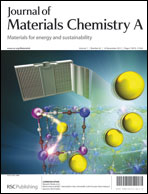Graphene modified carbon nanosheets for electrochemical detection of Pb(ii) in water
Abstract
A novel graphene modified carbon nanosheet (GMCN) was constructed by using graphene oxide as the shape-directing agent, and resorcinol and formaldehyde as carbon precursors through a surface assembly process. The GMCN can be used as an efficient electrochemical sensing material for Pb(II) detection in an aqueous solution using square wave anodic stripping voltammetry. Due to the efficient integration of porous features of the resin-based carbon and the excellent electrical conductivity of graphene, such materials possess a superior adsorption capacity and fast electron-transfer kinetics. The sensitivity is as high as 92.86 μA μmol−1 and a limit of detection as low as 1.12 nM has been reached. The thickness of the carbon nanosheets can be tuned by varying the reactant mass ratio, which ensures a tuneable electrical conductivity and surface area. A good balance between electrical conductivity and surface area allows a high adsorption capacity towards Pb(II), high signal-to-background ratio and rapid electron and ion diffusion paths for electrochemical reactions as well, which significantly improves the electrochemical sensing performance in the detection of Pb(II). Potentially, such nanosheet materials can be used in the field of heavy metal ion detection.


 Please wait while we load your content...
Please wait while we load your content...